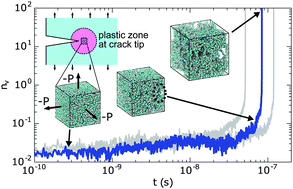Mechanics and nanovoid nucleation dynamics: effects of polar functionality in glassy polymer networks
Abstract
We use molecular simulations and experiments to rationalize the properties of a class of networks based on dicyclopentadiene (DCPD), a polymer with excellent fracture toughness and a high glass transition temperature (Tg), copolymerized with 5-norbornene-2-methanol (NBOH). DCPD is a highly non-polar hydrocarbon, while NBOH contains a hydroxy group, introducing polar functionality and hydrogen bonds (H-bonds). NBOH thus represents a possible route to improve the chemical compatibility of DCPD-based networks with less-hydrophobic materials. We systematically vary the NBOH content (polar chemistry) in DCPD networks, while keeping other network parameters nearly constant, including the molecular weight between cross-links, chain rigidity, and Tg. Using molecular dynamics (MD) simulations, we quantify the thermovolumetric and mechanical properties, including Tg, cohesive energy density, stiffness, and yield strength. We compare these results with experiments on networks of similar composition, finding good agreement. The relation between these properties and polar chemistry are studied by examining a secondary network of physical cross-links, formed by hydrogen bonds between NBOH units. Further, we examine nanovoid formation, an energy dissipation mechanism hypothesized to contribute to the toughness of pDCPD. Using metadynamics to accelerate sampling, we quantify the nanovoid nucleation rate under hydrostatic tension, similar to the stress state in the plastic zone preceding a crack tip. Small additions of NBOH have minimal effect, but the rate drops steeply with larger amounts. Several properties are mapped at nanometer scales, including stiffness and mobility, and associated with void nucleation. Estimates of the length- and time-scale of the plastic zone near a crack tip are used in discussing nanovoid formation as a plausible toughening mechanism in these materials. Overall, the results suggest that pDCPD tolerates the addition of some polar chemistry without degrading its excellent mechanical properties.



 Please wait while we load your content...
Please wait while we load your content...